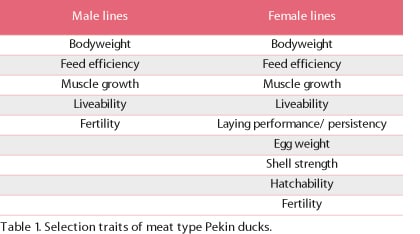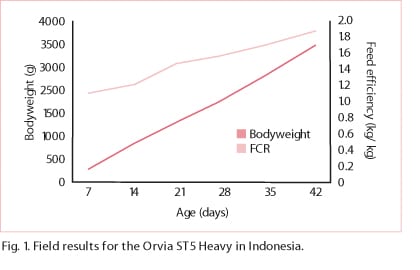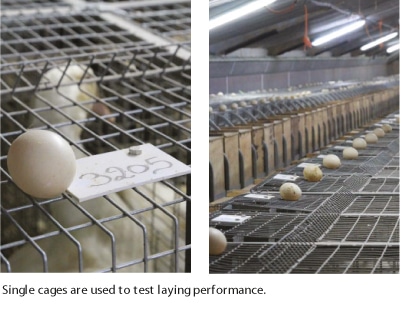May 2016 - Duck meat production
International Hatchery Practice – Volume 30 Number 6- 2016
The global production of duck meat was roughly 4.3 million tons in 2012. It represents a valuable source for human consumption especially in Asian countries. Most of this duck meat is produced by growing Pekin ducks.
By Dr Hans-Heinrich Thiele, Consultant Geneticist, Gourmaud Selection (Group Orvia).
To improve the efficiency of this business, breeding companies have been selecting for superior performance in all traits of economic importance. Selection is focused on daily gain, meatiness and feed efficiency of broiler ducks, without neglecting the number of ducklings per female housed.

Using more precise data recording tools, as for instance RFID based data recording and more powerful IT technology to estimate genetic parameters and breeding values, the performance has been much improved over the last 20 years.
The production of duck meat increased remarkably during the last 20 years, up to about 4.3 million tons in 2012. The main producer is China, producing more than 80% of all worldwide duck meat. According to information of Guémené et al. (2011) roughly 90% of it is based on fattened Pekin ducks. Only 4% of is produced by Muscovy ducks and 6% of it is available as a by-product from Mule ducks, used for the fatty liver production. Ducks have been very popular in Asia since historical times and they remain popular until today. The Chinese not only like the high nutritive value and tastiness of the duck meat, but also utilise their feet, tongues and other by-products for human consumption and appreciate the high quality of the feathers. The duck varieties, especially the Pekin ducks, are very robust and can be kept under various climatic conditions, often in very simple housing. Several breeding companies are selecting ducks for meat production. Although most of them are based outside of Asia, their market share in Asian countries is high and their breeding work has to consider market demands in Asia. This article will focus on the selection of Pekin ducks for meat production.
Relevant traits and performance testing

Similar to meat type chicken breeding programs, Pekin ducks are selected in specialised male and female lines, which are combined at the grandparent and parent level to produce commercial broiler ducks. In the male lines, the main focus of selection is on growth rate, feed efficiency, carcase yield and meat quality, while the female lines are also selected for egg production and hatchability. At 40-45 days, the broiler performance of all progeny of all pure lines and their crossbred offspring are tested. The data recorded by the selection crews are incorporated directly into the data bases. Since this is done very precisely with modern recording devices, the data are immediately available for parameter and breeding value estimation.
Improvement of feed efficiency by selection
Feed efficiency has become more and more important for all kinds of animal production, in response to rising feed cost and awareness of limited resources and environmental issues. Therefore, individual feed intake of the birds is measured and used in selection programs. In the past, individual feed intake of meat type poultry has been recorded in single cage systems, but this system is unfavourable for the ducks and may not reflect feeding behaviour under commercial floor conditions. The modern RFID technology enables the breeding companies nowadays to record even small meals of individuals under nearly practical housing conditions. In these testing units not only the amount of feed consumed can be recorded, it opens the possibility to observe also the feeding behaviour of the ducks, with the frequency of meals and the size of a single meal.
The availability and utilisation of these ‘feeding stations’ accelerates the genetic progress in feed efficiency. Companies which invested in this technology several years ago have already gained a huge advantage, while further developing their pure line breeding stock. Records of daily feed intake can be used to improve feed efficiency in combination with weight gain during the testing period as the commonly known FCR or, independent from metabolic body weight and weight gain, as Residual Feed Intake (RFI).
Residual Feed Intake (RFI) = FI – [a + b1 * BW0,75 + b2 * BWG]
FI = feed intake, BW = bodyweight, BWG = bodyweight gain

The laying performance is usually tested over a period of 45 production weeks. Traditionally laying birds are kept in single cage systems. Orvia is developing a fully automatic nest system to replace single cages in future. With the new nests the laying performance can be recorded in floor pens. During the testing period, time wise information about egg weight, shell strength, fertility and hatchability are recorded. Sperm quality is analysed before males are used for pedigree reproduction. For testing the fertility and hatchability of females, the use of pooled sperm is preferred.
Estimates of heritabilities and correlations among traits are summarised in Table 3. All selection criteria except liveability have a sufficiently high heritability to predict further improvement. Residual feed intake is (by definition) independent from body weight and a useful parameter to judge the conversion of feed to body mass. As in other poultry species, liveability has also limited genetic variation in Pekin ducks and will be a preferential candidate for genomic selection.
Genetic parameters and breeding values

In these days very powerful IT technology and software tools are available which enable the geneticists to estimate the breeding values.
A quick and precise data recording combined with those possibilities enables the specialists to select the progeny of each pure line. Based on line-specific indices, the quality of males and females is judged to select and mate ducks for the next pure line pedigree generation.
All economically relevant traits have to be combined in such a way, that the strategic importance of each line and its position in the crossbreeding program is taken into consideration. The main target is to improve the performance of the final product, while maintaining or improving the performance in the parent stock as well.
Results
The parent performance of the heavy package is around 230-240 ducklings in 52 weeks of production. Heavy hybrids have an outstanding broiler performance. They grow in six weeks of age to a bodyweight of 3300-3500g. Depending on the nutrient density of the supplied feed; the feed conversion is below 2kg feed per kg bodyweight.
Concerning meat quality, those broiler ducks produce 32-35% of muscles (skin included) of their live bodyweight and have at slaughter 72-75% yield. The annual selection progress for heavy packages can be predicted with 50-70g higher bodyweight at six weeks, 30-50g less feed for 1kg gain and about one more egg per parent.

Summary
Pekin ducks contribute substantially to the production of food for human consumption, especially in Asian countries. The breeding activities can enhance the effectiveness of that special part of poultry production. Comparable to other poultry species the genetics are concentrated in only a few but highly specialised companies. Duck specific performance testing and breeding value estimation is done with sophisticated tools and will be constantly further developed. Genetic progress will continue in all economically important traits.
References are available from the author on request